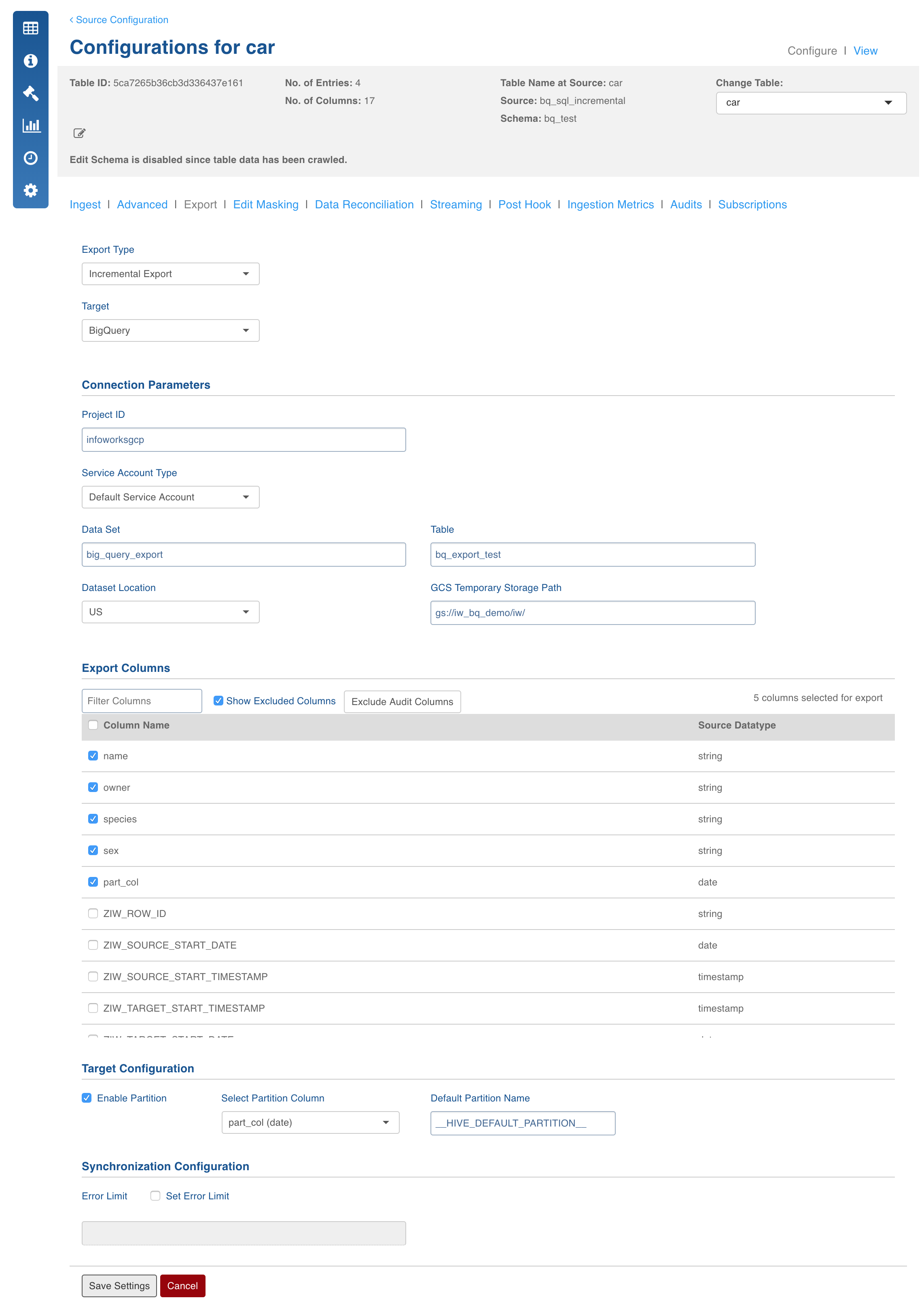Field Description
- Export Type: Select Full Export/Incremental Export.
- Target Database: Select the database type to be exported as BigQuery.
- Project ID: Enter the Google Cloud project in which the BigQuery tables will be exported.
- Service Account Type:
- Select Default to use the service account of the dataproc cluster.
- Select Custom to specify a credential json file. This displays a textbox for entering the file path to Service Account Json file. Note that this must be available from edge node and cluster nodes.
- Dataset: Enter the BigQuery dataset name.
- Table: Enter the BigQuery table name.
- Dataset Location: Select US or EU. Default is US.
- GCS Temporary Storage Path: Enter the path to Google Cloud Storage folder which is accessible to Infoworks application. This is used as temporary storage during load to BigQuery. Ensure that the service account has read/write access to this storage path.
- Export Columns: Select the columns that must be exported to the target table. At least one column must be selected. The Select All and Deselect All buttons can be used to make the selection faster.
- Target Configuration: Select a Partition column to be used in the BigQuery table. It can have only date or timestamp type. Leave it unchecked in case you do not want partitions in BigQuery.
- Enable Partition: Select this checkbox to specify a partition column.

NOTE: To enable partition for BigQuery target table, the Hive table must be partitioned.
- Select Partition Column: Select the partition column.
- Synchronization Configuration:
- Set Error Limit: Select this checkbox to specify an error limit.
- Error Limit: Enter the limit on the numbers of rows which will be allowed before failing the BigQuery load job.
BigQuery Export Datatypes
The export feature supports the following datatypes in Hive:
- TINYINT
- SMALLINT
- INTEGER
- BIGINT
- TIMESTAMP
- DATE
- STRING
- BOOLEAN
- BINARY
- CHAR
- VARCHAR
- STRUCT
- ARRAY
BigQuery does not support the following datatypes:
- UNION
- MAP
Best Practices
If you use partitioning for incremental load, use a partition column which is a good indicator of incremental changes. For instance, a Sale_Date column for Sales table is a good choice for incremental partition as daily jobs will have only one incremental partition to load to BigQuery.
Permissions for BigQuery Data Load
The permissions required to write to BigQuery as per the documents of google cloud (https://cloud.google.com/bigquery/docs/tables) are as follows:
- To create a table, you must have WRITER access at the dataset level, or you must be assigned a project-level IAM role that includes bigquery.tables.create permissions.
- The following predefined, project-level IAM roles include bigquery.tables.create permissions:
- bigquery.dataEditor
- bigquery.dataOwner
- bigquery.admin
- Also, for temporary storage the storage.objectAdmin role should have access to the location provided in GCS Temporary Storage Path.
NOTE: Binary datatype is currently not supported.
IW Constants and Configurations
- iw_bq_parallelism: The number of partitions to load in parallel. Default value is 10.
- bq_staging_cleanup: Indicates whether the temporary storage must be cleaned after the job is successful. Default value is true.
- bq_view_create: Indicates whether a view should be created in BigQuery for the partitioned tables loaded using partition column provided as alias to _PARTITIONTIME. Default value is false.
- bq_hive_aux_jars: The path to hcatalog and GCS connector jars. Default value is /usr/lib/hive-hcatalog/share/hcatalog/hive-hcatalog-core.jar,/usr/lib/hadoop/lib/gcs-connector-latest-hadoop2.jar.
BigQuery Datatype Mapping
BigQuery export supports limited datatype mapping. For example, mapping within numeric family - decimal, integer, long to numeric; timestamp to datetime.
The column types can be remapped using the following configuration at table-level or pipeline-level:
bq_col_overrides: The configuration to remap the column type.
- Value:
<ColumnName1>:-:FLOAT,<ColumnName2>:-:FLOAT - Example: eid:-:FLOAT,sales:-:FLOAT
- Separator: :-:
The BigQuery NUMERIC datatype is slightly different than Hive DECIMAL in the precision and scale ranges. BigQuery precision can range from 0-38 and scale from 0-9 compared to Hive (38,38). Also, the precision-scale difference should not be more than 29. So, an integer of maximum length 29 is supported. After this limit, you can remap the columns to Float.
Remapping can be done within same numeric family. For example, mapping Decimal to Integer.
BigQuery ColumnName Override
The column names can be overridden during export using the following configuration:
bq_col_name_override: The configuration to rename the column name.
- Value:
<SourceColumnName1>:-:<TargetColumnName1>``,<SourceColumnName2>:-:``<TargetColumnName2> - Example: eid_source:-:eid_target,sales_source:-:sales_target
- Separator: :-: